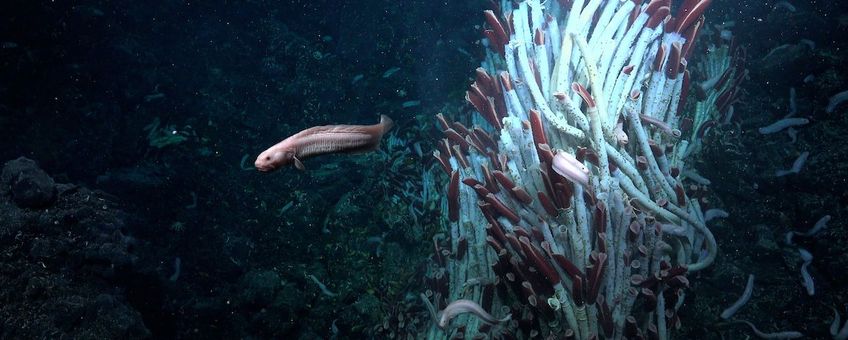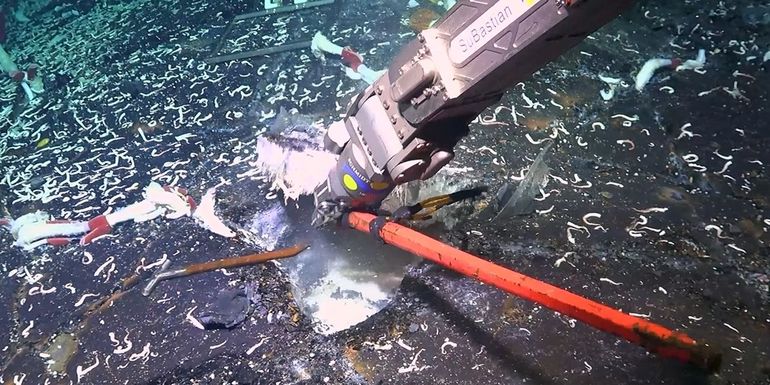
Scientists discover new ecosystem underneath hydrothermal vents
NIOZ Royal Netherlands Institute for Sea ResearchNew underground habitats
The discovery is made by an international team including marine biologist Sabine Gollner of Royal Netherlands Institute for Sea Research (NIOZ). “Scientists have spent the past 46 years studying hydrothermal vents but have never looked for animals under these volcanic hot springs,” says Sabine Gollner. “We were thrilled when we peeked into the underground cavities, full of live. This discovery adds a new dimension to hydrothermal vents, showing that life exist both above and below the surrounding seafloor.”
“Our understanding of animal life at deep-sea hydrothermal vents has greatly expanded with this discovery,” said expedition leader Monika Bright. “Two dynamic vent habitats exist. Vent animals above and below the surface thrive together in unison, depending on vent fluid from below and oxygen in the seawater from above.”
Unique Dutch experiment
The expedition took the scientists to the undersea volcano on the East Pacific Rise off Central America at 2.500 metres depth. To determine if animals travel through vent fluids, the science team used Schmidt Ocean Institute’s underwater robot ROV SuBastian and new equipment developed by NIOZ. “We developed special mesh boxes in the Netherlands, which were glued over cracks in the earth’s crust,” says Sabine Gollner. “When we removed the boxes after several days along with the crust, we discovered animals living below the surface in hydrothermal caves.”

Animals travel through the subsurface
Additionally, the researchers found evidence of vent animals, like tubeworms, traveling underneath the seafloor through vent fluid to colonize new habitats. Tubeworms are one of the best-known hydrothermal vent animals but very few of their young have been found in the water above hydrothermal vents. This led scientists to suspect they travel beneath the earth’s surface to create new hydrothermal communities.
Hydrothermal vents act like underwater hot springs that flow through cracks in the earth’s crust because of tectonic activity. When a new hydrothermal vent appears, the ecosystem rapidly follows as animals colonize an area within a few years. How animal larvae find new vent fields is unknown by scientists. The international team is the first to examine and confirm that tubeworm larvae can settle and even live underneath the seafloor. Finding an entirely new ecosystem below the seabed surface provides evidence that this may be the case.
Researchers uncover unique life in the deep (Source: Schmidt Ocean Institute)
Fully explore our ocean
“The discoveries made on each Schmidt Ocean Institute (SOI) expedition reinforce the urgency of fully exploring our ocean, so we know what exists in the deep sea," said Wendy Schmidt, president and co-founder of SOI. "The discovery of new creatures, landscapes, and now, an entirely new ecosystem underscores just how much we have yet to discover about our ocean--and how important it is to protect what we don't yet know or understand."
“On land we have long known of animals living in caves underground and in the ocean, of animals living in sand and mud, but for the first time, scientists have looked beneath hydrothermal vents,” said SOI’s Executive Director, Jyotika Virmani. “This truly remarkable discovery of a new ecosystem, hidden beneath another ecosystem, provides fresh evidence that life exists in incredible places. Schmidt Ocean Institute is proud to have provided a platform for Dr. Bright and her team to gather new insights into these systems that may be vulnerable to deep-sea mining.”
Collaboration
The 30-day expedition aboard Schmidt Ocean Institute’s research vessel Falkor (too) was led by Monika Bright, University of Vienna. Along with an international science team from the the Netherlands, United States, Germany, France, Costa Rica, and Slovenia they visited the undersea volcano on the East Pacific Rise off Central America.
Text and photos: NIOZ (lead photo: eelpouts and tubeworms)
Film: Schmidt Ocean Institute
